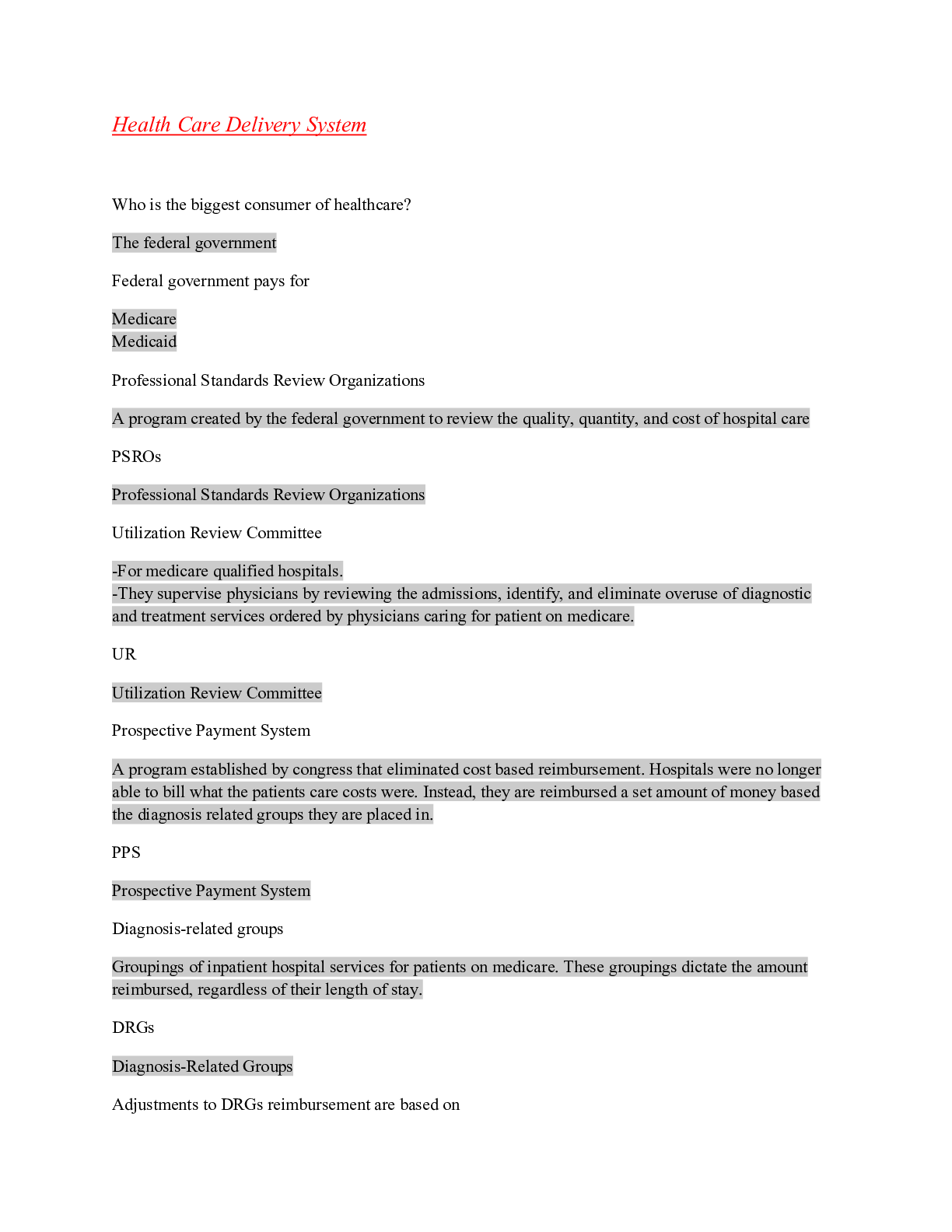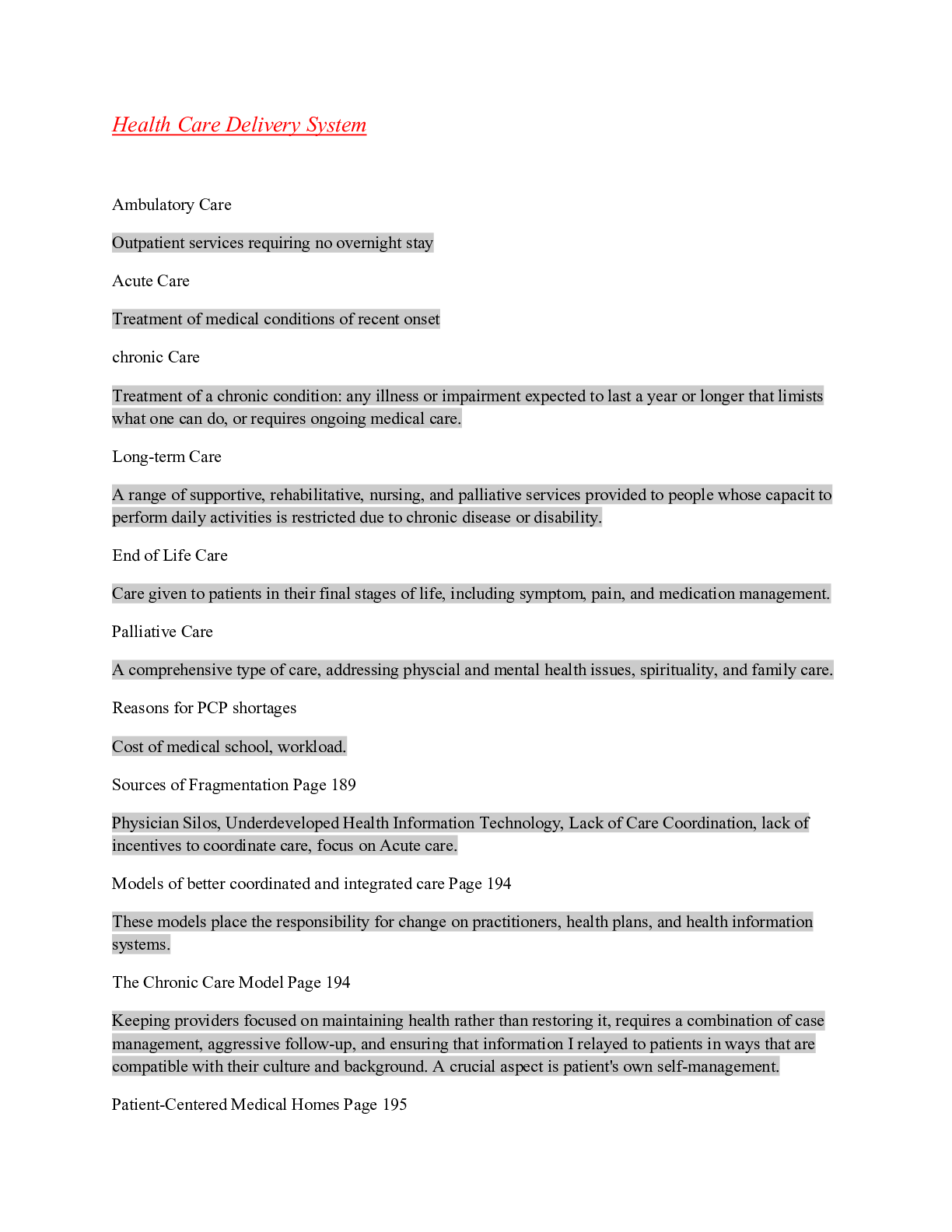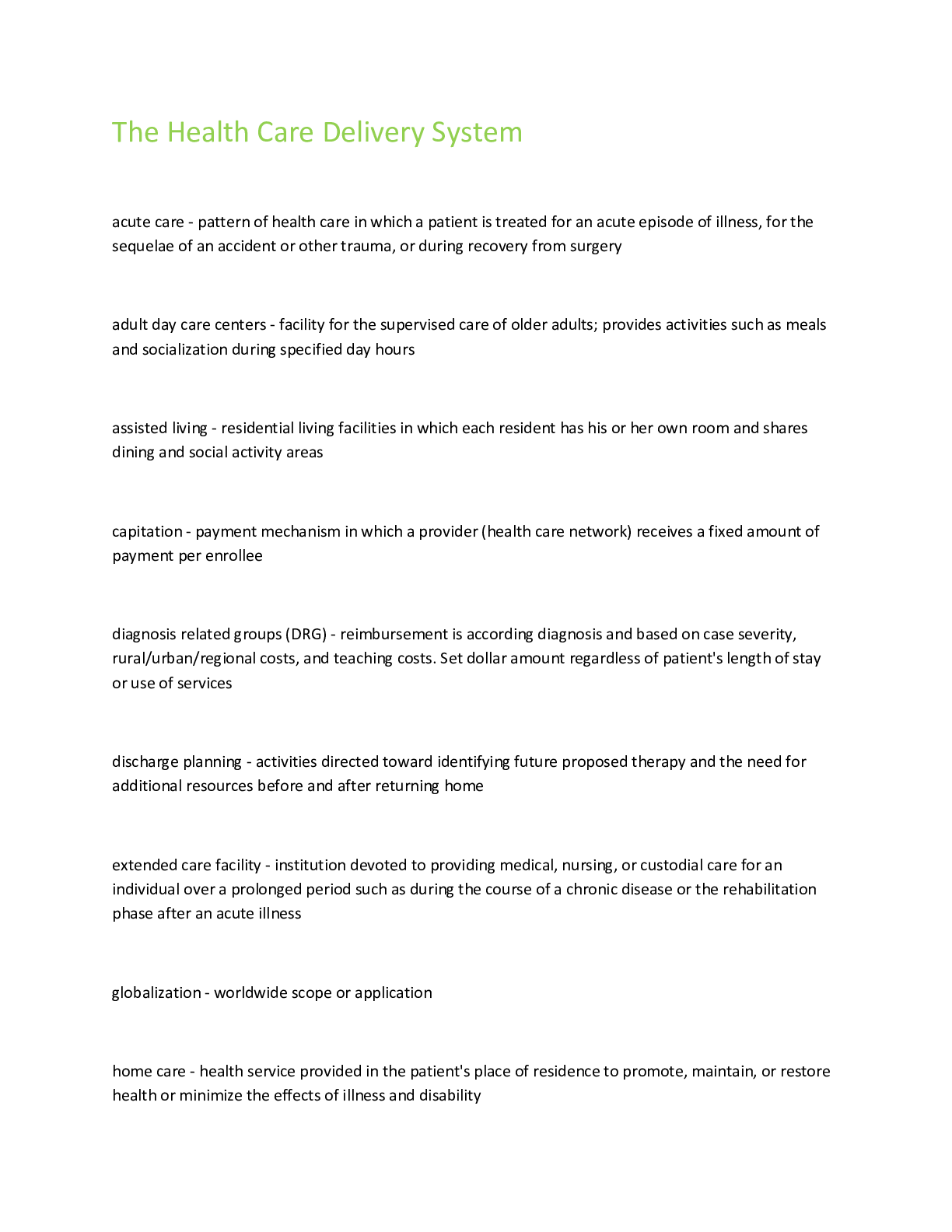Health Care > EXAM > CH 2 The Health Care Delivery System Exam Guide Questions; Latest (All)
CH 2 The Health Care Delivery System Exam Guide Questions; Latest
Document Content and Description Below
CH 2 The Health Care Delivery System Exam Guide Questions; Latest CH 2 The Health Care Delivery System 1. The nurse is caring for a patient who is on Medicare. Because the patient is on Medica... re, the nurse is aware that a. The hospital will be paid for the full cost of the patient's hospitalization. b. Capitation provides the hospital with a means of recovering variable charges. c. Diagnosis-related groups (DRGs) provide a fixed reimbursement of cost. d. Medicare will pay the national average for the patient's condition. ANS: C In 1983, Congress established the prospective payment system (PPS), which grouped inpatient hospital services for Medicare patients into 468 diagnosis-related groups (DRGs), each of which provides a fixed reimbursement amount based on assigned DRG, regardless of a patient's length of stay or use of services. This encourages hospitals to provide more efficient services because costly stays may not be fully covered. Capitation means that providers receive a fixed amount per patient or enrollee of a health care plan. DRG reimbursement is based on case severity, rural/urban/regional costs, and teaching costs, not national averages. DIF: Understand REF: 15 OBJ: Compare the various methods for financing health care. TOP: Assessment MSC: Teaching/Learning 2. The advent of diagnosis-related groups (DRGs) and capitation has brought about many changes in how health care is provided and paid for. Because of these changes, the nurse is aware that today's managed care system has a. Insured full coverage of health care costs. b. Assumed all of the financial risk involved. c. Allowed providers to focus on illness care. d. Caused providers to focus on illness prevention. ANS: D Managed care describes health care systems in which the provider or the health care system receives a predetermined capitated payment for each patient enrolled in the program. Capitation means that providers receive a fixed amount per patient or enrollee of a health care plan. The actual cost of care is the responsibility of the provider. In this case, the managed care organization (provider) assumes financial risk, in addition to providing patient care. The focus of care of the organization shifts from individual illness care to prevention, early intervention, and outpatient care. DIF: Understand REF: 15 OBJ: Explain the advantages and disadvantages of managed health care. TOP: Assessment MSC: Teaching/Learning 3. A major outcome of managed care is that managed care organizations such as hospitals a. Assume financial risk, as well as provide care. b. Focus more on individual illness. c. Decrease discharge planning activities. d. Have increased lengths of stay. ANS: A As a result of managed care and prospective payment systems, the managed care organization assumes financial risk, in addition to providing patient care. The organization's focus of care shifts from individual illness care to concern for the health of its covered population. If people stay healthy, the cost of medical care declines. Soon after prospective payment began, hospitals started to increase discharge planning activities, and lengths of stay began to shorten. DIF: Knowledge REF: 15 OBJ: Explain the advantages and disadvantages of managed health care. TOP: Assessment MSC: Teaching/Learning 4. Care designed to prevent further progression of a disease is termed a. Primary prevention. b. Secondary prevention. c. Tertiary prevention. d. Health promotion. ANS: C Tertiary prevention is defined as care that prevents further progression of disease. Primary prevention consists of health-promoting behaviors or activities that reduce the occurrence of an illness. Secondary prevention is early diagnosis and treatment of illness (e.g., screening for hypertension). Health promotion includes activities that develop human attitudes and behaviors to maintain or enhance well-being. DIF: Remember REF: 17-18 OBJ: Discuss the types of settings that provide various health care services. TOP: Assessment MSC: Teaching/Learning 5. The nurse is applying for a position with a home care organization that specializes in spinal cord injury. In doing so, the nurse is applying for a position in _____care. a. Secondary acute b. Tertiary c. Continuing d. Restorative ANS: D Restorative care is designed to help the patient reach optimal recovery from disease or injury. Included in this type of care are cardiovascular and pulmonary rehabilitation, sports medicine, spinal cord injury programs, and home care. Secondary acute care involves emergency care, acute medical-surgical care, and radiological procedures. Tertiary care includes intensive care and subacute care. Continuing care involves long-term assisted living, psychiatric care, and older adult day care. DIF: Understand REF: 17 OBJ: Discuss the types of settings that provide various health care services. TOP: Implementation MSC: Caring 6. The patient is to be discharged home from a tertiary care center later in the week therefore, the nurse a. Coordinates referral of patients to services provided by other disciplines. b. Monitors the patient's progress through discharge. c. Cares for patients after discharge. d. Anticipates and identifies patient needs. ANS: D Nurses play a large role in discharge planning. To achieve continuity of care, nurses use critical thinking skills and apply the nursing process. To anticipate and identify the patient's needs, nurses work with all members of the multidisciplinary health care team. The case manager coordinates the referral of patients to services provided by other disciplines and monitors the patient's progress through discharge. In many settings, a case manager continues caring for patients after discharge from acute care facilities. DIF: Apply REF: 19 OBJ: Discuss the role of nurses in different health care delivery settings. TOP: Implementation MSC: Caring 7. The nurse is serving on the hospital's Quality Improvement Committee. As the nursing representative, the nurse focuses quality improvement measures on a. Outcomes unrelated to patient satisfaction. b. Desired health outcomes. c. Factors solely affecting inpatients. d. Increasing patient-to-nurse ratios. ANS: B Nursing plays an important role in quality and safety in health care. Quality health care is the "degree to which health services for individuals and populations increase the likelihood of desired health outcomes and are consistent with current professional knowledge." Health care providers define the quality of their services by measuring health care outcomes that show how a patient's health status has changed. Many of the aspects reflected in patient satisfaction apply to almost any health care setting. Research has found that hospitals that improved the nursing work environment and lowered nurse-to-patient ratios by one patient had higher patient satisfaction levels and patients who were more likely to recommend the hospital to others. DIF: Apply REF: 23-24 OBJ: Explain the impact of quality and safety initiatives on delivery of health care. TOP: Implementation MSC: Caring 8. The nurse is trying to determine how well a certain health plan compares with other health plans. To gather this type of information, the nurse utilizes the a. Healthcare Effectiveness Data and Information Set (HEDIS). b. Centers for Medicaid and Medicare Services (CMS) standards. c. Pew Health Professions Commission Report. d. American Nurses Credentialing Center (ANCC) Magnet Recognition Program. ANS: A Health plans throughout the United States rely on the Healthcare Effectiveness Data and Information Set (HEDIS) as a quality measure. HEDIS compares how well health plans perform in three key areas: quality of care, access to care, and patient satisfaction with the health plan and doctors. CMS created quality standards for health care facilities, as well as health care providers. The 1998 Pew Health Professions Commission recommended 21 competencies for health care professionals. The Magnet Recognition Program recognizes health care organizations that achieve excellence in nursing practice. DIF: Apply REF: 24-25 OBJ: Explain the impact of quality and safety initiatives on delivery of health care. TOP: Implementation MSC: Caring 9. The student nurse is reporting to her group in post-conference about her observational rotation in the intensive care unit. The student states that "it seems so much easier than floor nursing because everything is automated. There are machines that take vital signs and regulate IVs." The instructor's best response is to a. Agree with the student's evaluation of ICU nursing. b. Agree that IV pumps have made IV therapy totally safe. c. Disagree, stressing the importance of taking vital signs themselves. d. Disagree, stressing the importance of the nurse's judgment. ANS: D The instructor cannot fully agree with the student's statements. In many ways, technology makes the nurse's work easier, but it does not replace the nurse's judgment. An electronic infusion device provides a constant rate of infusion, but nurses need to be sure that they calculate the rate correctly and troubleshoot problems. Electronic equipment may take vital signs, but it is the nurse's responsibility to interpret the vital signs in relation to the patient's condition. DIF: Analyze REF: 27 OBJ: Discuss the implications that changes in the health care system have for nursing. TOP: Evaluation MSC: Caring 10. When the nurse first meets the patient, it is important to establish a dialogue if possible patient-centered care stresses that it is important for the nurse to recognize that a. Patients usually want to rely on the nurse for patient care. b. Patients usually want to keep their fears and concerns to themselves. c. It is important to identify patient expectations. d. Patients usually have insurance and do not worry about finances. ANS: C It is important for nurses to recognize the need to identify patient expectations in patient-centered care. The seven dimensions of patient-centered care indicate that patients and family members want to know how to manage their care on their own. They also look to care providers to share their fears and concerns. One concern is their ability to pay for their medical care, and patients identify staff members who will help alleviate this worry. DIF: Apply REF: 25 OBJ: Discuss the implications that changes in the health care system have for nursing. TOP: Implementation MSC: Caring 11. In today's society, the nurse is facing more and different challenges. Central to some of these challenges is the concept of globalization, because it has led to a. A more homogeneous mix of nursing staff. b. Decreased poverty and increased diseases of affluence. c. Decreased urbanization as populations shift to the suburbs. d. Increased spread of communicable diseases. ANS: D Although globalization of trade, travel, and culture has improved the availability of health care services, the spread of communicable diseases such as tuberculosis and severe acute respiratory syndrome (SARS) has become more common. In an effort to improve the quality of care, health care institutions are recruiting nurses from around the world to work in the United States, forcing hospitals to better understand and work with nurses from different cultures. Poverty is still deadlier than any disease and is the most frequent reason for death in the world today. The growth of urbanization also is currently affecting the world's health. DIF: Understand REF: 27-28 OBJ: Discuss the implications that changes in the health care system have for nursing. TOP: Evaluation MSC: Caring 12. The nurse is feeling overwhelmed by the constant changes that are part of nursing and the health care system in general. Understanding that changes are necessary, the nurse needs to be aware that a. The nurse has no control over the changes, but needs to accept them. b. Quality improvement depends on active participation of nurses. c. Belonging to nursing organizations will help bring the right changes. d. Active participation in nursing organizations will have no effect on change. ANS: B Professional nursing is an important player in the future of health care delivery. The solutions necessary to improve the quality of health care depend largely on the active participation of nurses. Thus, nurses have potential control over health care changes. Belonging to nursing organizations is a start, but simply belonging is not enough. Active participation is needed. DIF: Understand REF: 28 OBJ: Discuss opportunities for nursing within the changing health care delivery system. TOP: Evaluation MSC: Caring 13. Which of the following, established by Congress in 1983, eliminated cost-based reimbursement for patients who received Medicare benefits? a. Prospective payment system (PPS) b. Professional standards review organizations (PSROs) c. Utilization review (UR) committees d. Capitation ANS: A Established by Congress in 1983, the PPS eliminated cost-based reimbursement. The federal government, the biggest consumer of health care, which pays for Medicare and Medicaid, has created professional standards review organizations (PSROs) to review the quality, quantity, and costs of hospital care. Medicare-qualified hospitals had physician-supervised utilization review (UR) committees to review the admissions and to identify and eliminate overuse of diagnostic and treatment services ordered by physicians caring for patients on Medicare. Capitation aims to build a payment plan for select diagnoses or surgical procedures that consists of the best standards of care at the lowest cost. DIF: Remember REF: 15 OBJ: Compare the various methods for financing health care. TOP: Assessment MSC: Teaching/Learning 14. The setting of health care services that includes blood pressure and cancer screening is _____ care. a. Secondary acute b. Preventive c. Tertiary d. Restorative ANS: B Preventive care includes blood pressure and cancer screening, immunizations, poison control information, mental health counseling and crisis prevention, and community legislation. Secondary acute care involves emergency care, acute medical-surgical care, and radiological procedures for acute problems (e.g., x-rays, CT scans). Tertiary care includes intensive care and subacute care. Restorative care deals with cardiovascular and pulmonary rehabilitation, sports medicine, spinal cord injury programs, and home care. DIF: Remember REF: 17 OBJ: Discuss the types of settings that provide various health care services. TOP: Assessment MSC: Teaching/Learning 15. Health promotion programs focus on a. Reducing the cost of health care. b. Controlling risk factors for disease. c. Immunizations. d. Occupational health programs. ANS: A Health promotion programs lower the overall costs of health care by reducing the incidence of disease, minimizing complications, and thus reducing the need to use more expensive health care resources. In contrast, preventive care is more disease oriented and is focused on reducing and controlling risk factors for disease through activities such as immunization and occupational health programs. DIF: Remember REF: 17 OBJ: Differentiate primary care from primary health care. TOP: Assessment MSC: Teaching/Learning 16. The nurse is caring for a patient who has a diagnosis that she is not familiar with. The nurse uses reference materials and does a literature search to better understand the diagnosis. The nurse then utilizes this knowledge, along with the nurse's experience and patient preferences, to develop a plan of care. This is an example of the nurse using _____ to provide care for her patient. a. Evidence-based practice b. Research-based practice c. Applied quality improvement d. Nursing informatics ANS: A Evidence-based practice is a problem-solving approach to clinical practice that involves the conscientious use of current best evidence, along with clinical expertise and patient preferences and values, in making decisions about patient care. Evidence-based practice, research-based practice, and best practice are terms that are often used interchangeably. However, research-based practice refers to the use of knowledge based on results of research studies, whereas evidence-based practice adds a nurse's clinical experience, practice trends, and patient preferences. Applied quality improvement involves identifying errors and hazards in care 1. Government-instituted programs designed to control health care costs include (Select all that apply.) a. Professional standards review organizations (PSROs). b. Prospective payment systems (PPSs). c. Diagnosis-related groups (DRGs). d. "Never events." e. Third-party payers. ANS: A, B, C The federal government, the biggest consumer of health care, which pays for Medicare and Medicaid, has created professional standards review organizations (PSROs) to review the quality, quantity, and costs of hospital care. One of the most significant factors that influenced payment for health care was the prospective payment system (PPS). Established by Congress in 1983, the PPS eliminated cost-based reimbursement. Hospitals serving patients who received Medicare benefits were no longer able to charge whatever a patient's care cost. Instead, the PPS grouped inpatient hospital services for Medicare patients into diagnosis-related groups (DRGs). In 2006, the National Quality Forum (not a government agency) defined a list of 28 "never events" that are devastating and preventable. Through most of the twentieth century, few incentives existed for controlling health care costs. Insurers or third-party payers paid for whatever health care providers ordered for a patient's care and treatment. DIF: Understand REF: 15 OBJ: Explain the advantages and disadvantages of managed health care. TOP: Assessment MSC: Teaching/Learning 2. Primary health care focus includes (Select all that apply.) a. Individual health screenings. b. Community health promotion programs. c. Development of health policies. d. Disease prevention in communities. e. Discharge planning for individual patients. ANS: B, C, D Primary care focuses on health services provided on an individual basis, whereas primary health care focuses on improved health outcomes for an entire population. This model emphasizes health promotion, the development of health policies, and prevention of disease within communities. Individual health screenings and discharge planning are primary care areas because they focus on the individual. DIF: Understand REF: 17 OBJ: Differentiate primary care from primary health care. TOP: Assessment MSC: Teaching/Learning 3. The nurse is evaluating the Falls Program instituted on the medical unit to decrease the number of falls. The number of falls has decreased in the last month. The nurse realizes that (Select all that apply.) a. The program has been successful and can be terminated. b. Policies for the program need to be developed or evaluated further. c. The program evaluation is a nursing-sensitive outcome that can enhance safety. d. The program results need to be reported to the QI Committee only. ANS: B, C Nurses and health care facilities use nursing-sensitive outcomes to improve nurses' workloads, enhance patient safety, and develop sound policies related to nursing practice and health care. DIF: Analyze REF: 26 OBJ: Explain the impact of quality and safety initiatives on delivery of health care. TOP: Evaluation MSC: Caring 4. Nurses who work in a skilled nursing facility need nursing expertise in which of the following areas? (Select all that apply.) a. Gerontological nursing b. IV fluid management c. Ventilator management d. Depression/violent behavior management e. Wound care management ANS: A, B, C, E An intermediate care or skilled nursing facility offers skilled care provided by a licensed nursing staff. This often includes administration of IV fluids, wound care, long-term ventilator management, and physical rehabilitation. Patients receive extensive supportive care until they are able to move back into the community or into residential care. Nurses who work in a skilled nursing facility need nursing expertise similar to that of nurses working in acute care inpatient settings, along with a background in gerontological nursing principles. Patients who suffer emotional and behavioral problems such as depression, violent behavior, and eating disorders often require special counseling and treatment in psychiatric facilities. [Show More]
Last updated: 1 year ago
Preview 1 out of 9 pages
Instant download
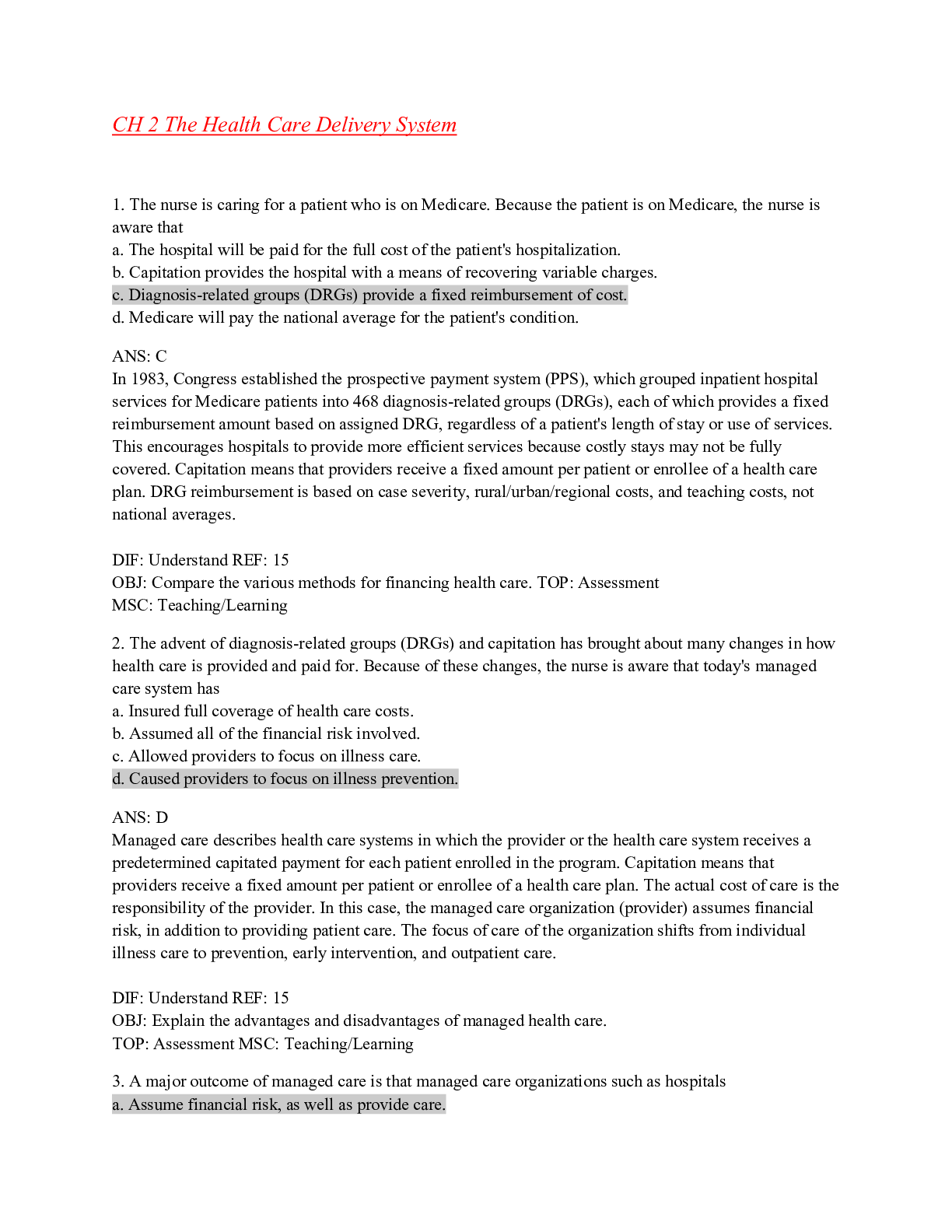
Buy this document to get the full access instantly
Instant Download Access after purchase
Add to cartInstant download
Reviews( 0 )
Document information
Connected school, study & course
About the document
Uploaded On
Nov 21, 2022
Number of pages
9
Written in
Additional information
This document has been written for:
Uploaded
Nov 21, 2022
Downloads
0
Views
48


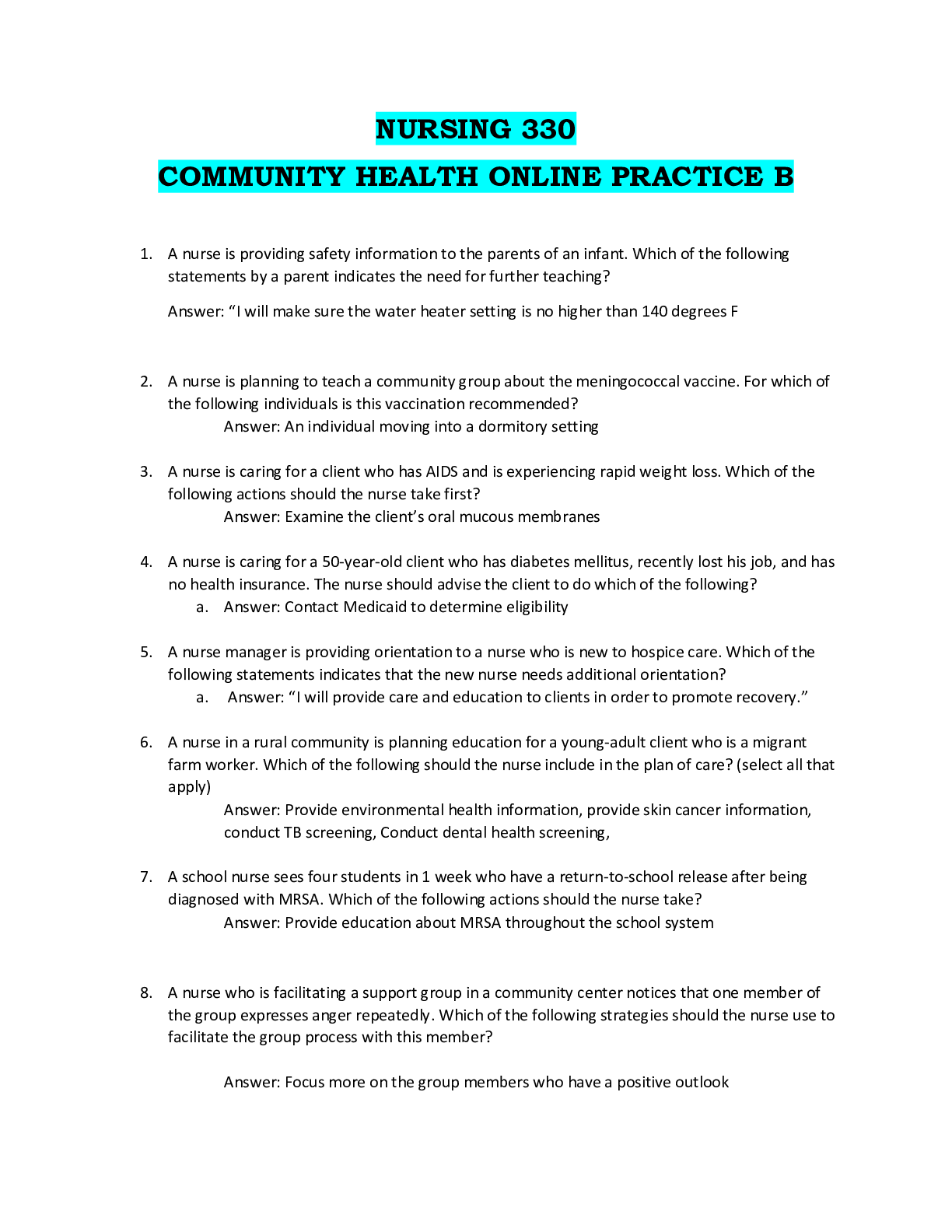
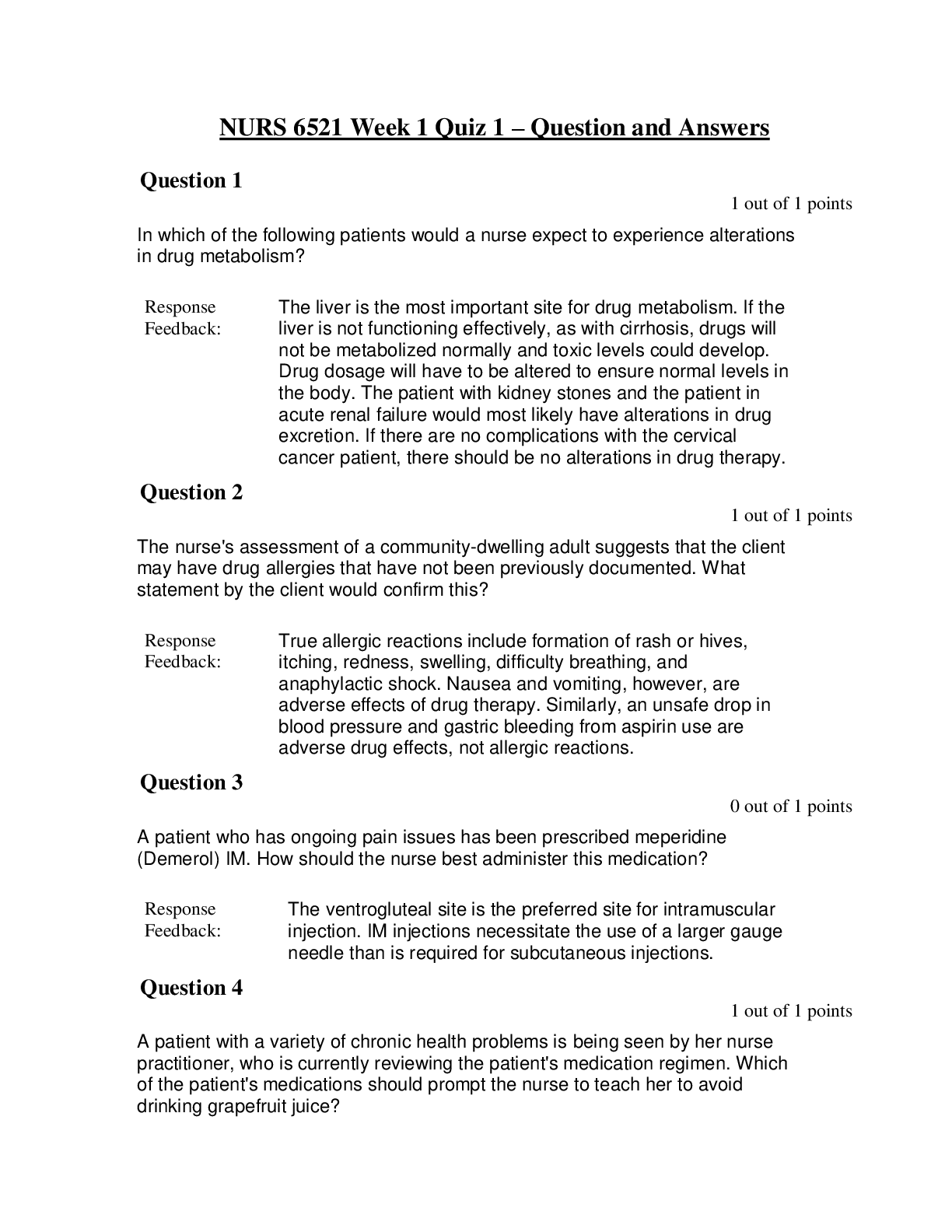




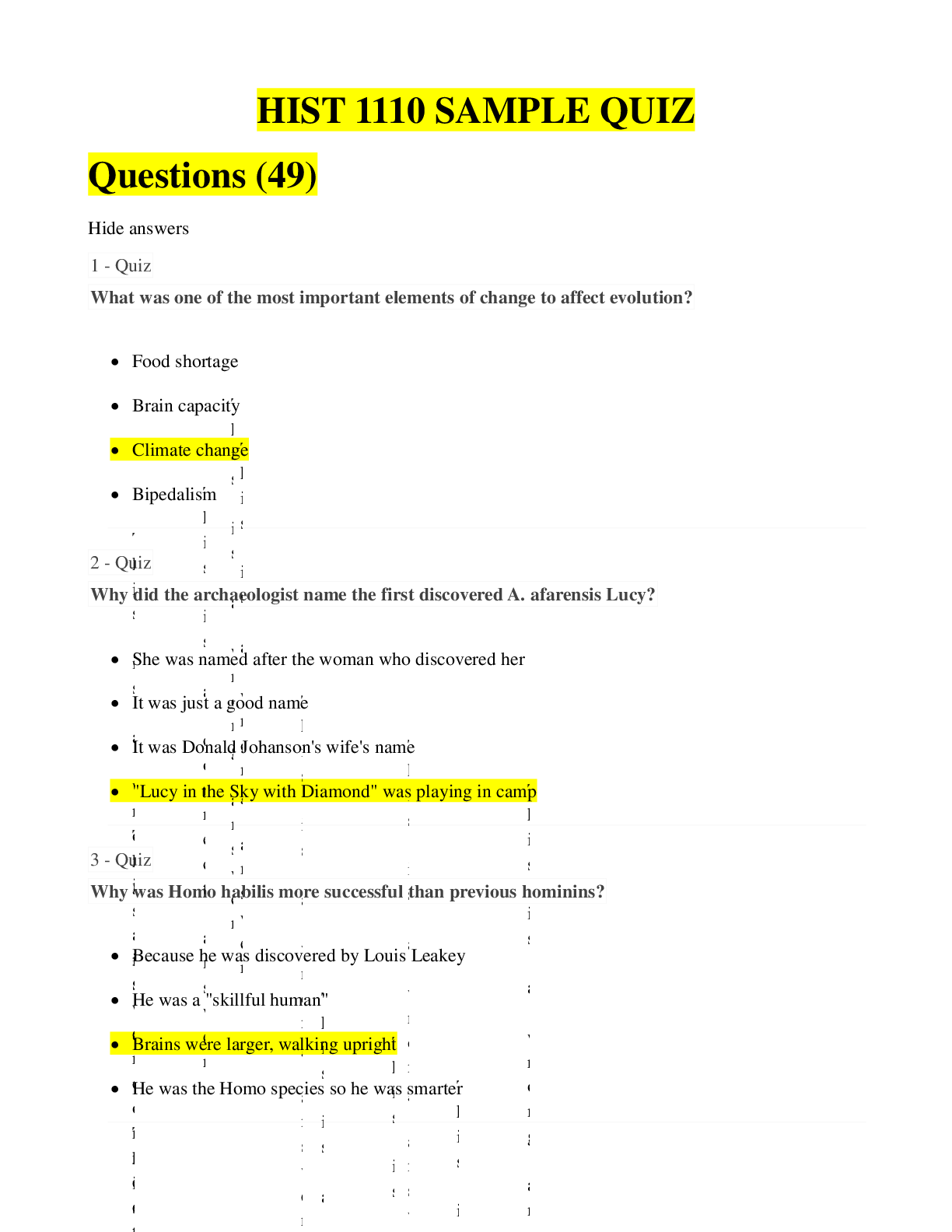
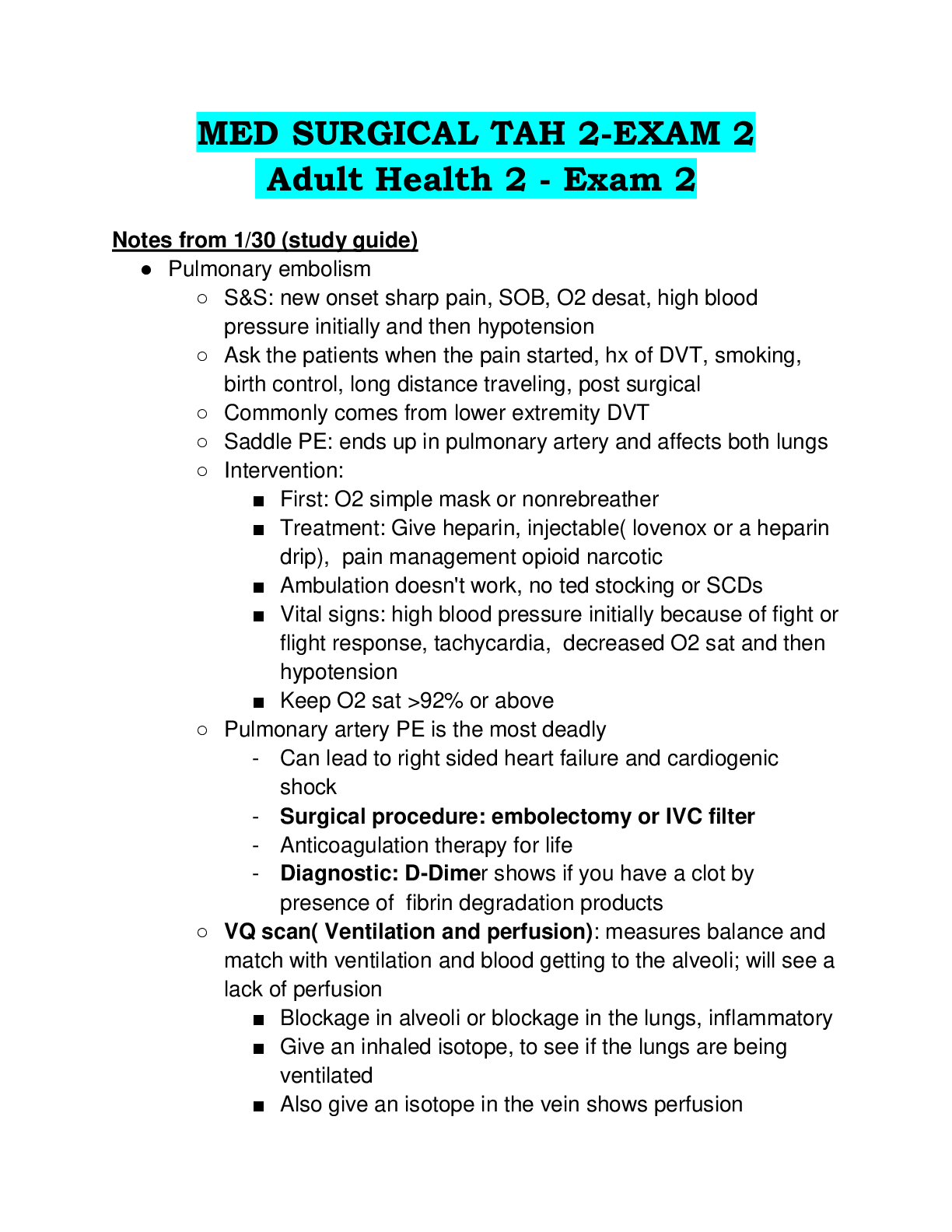

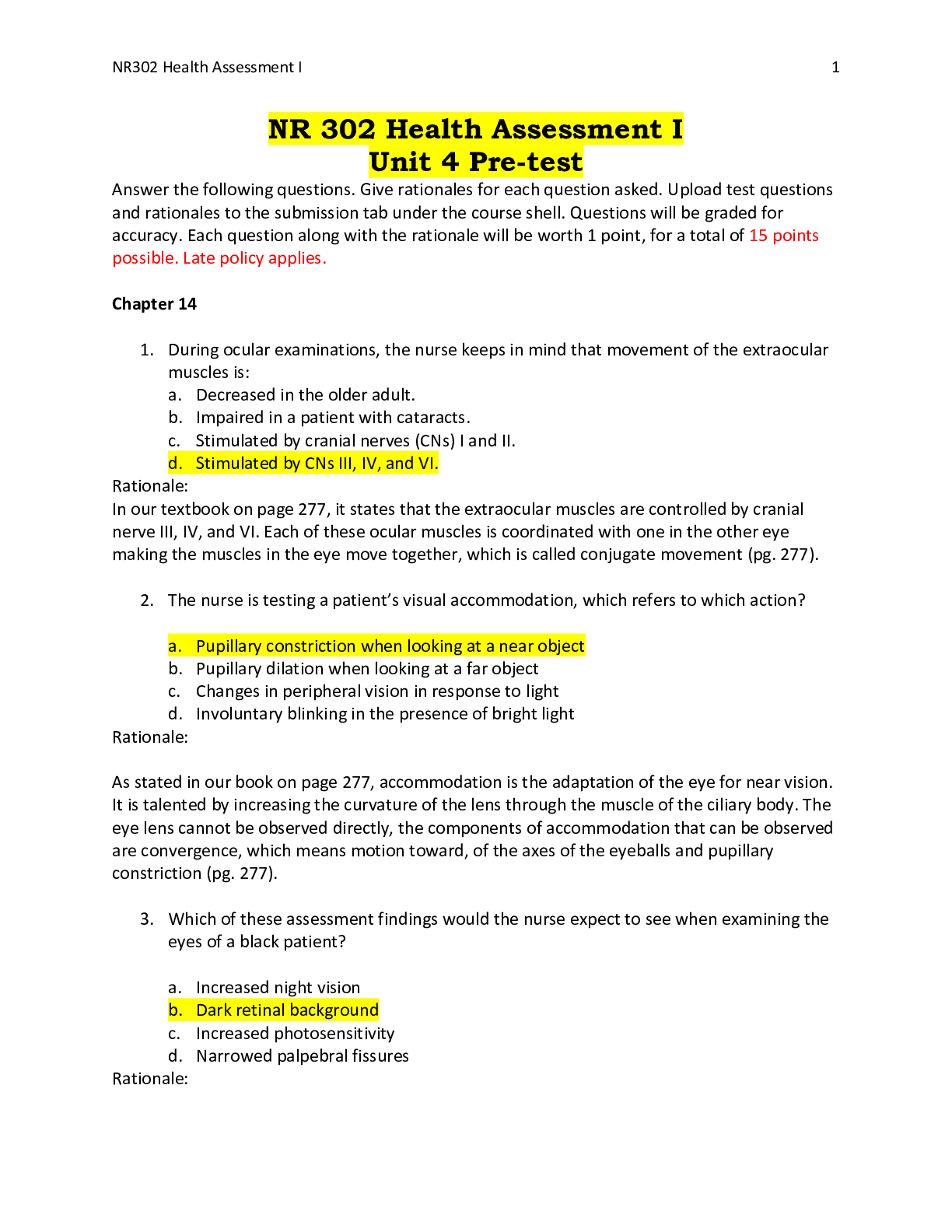

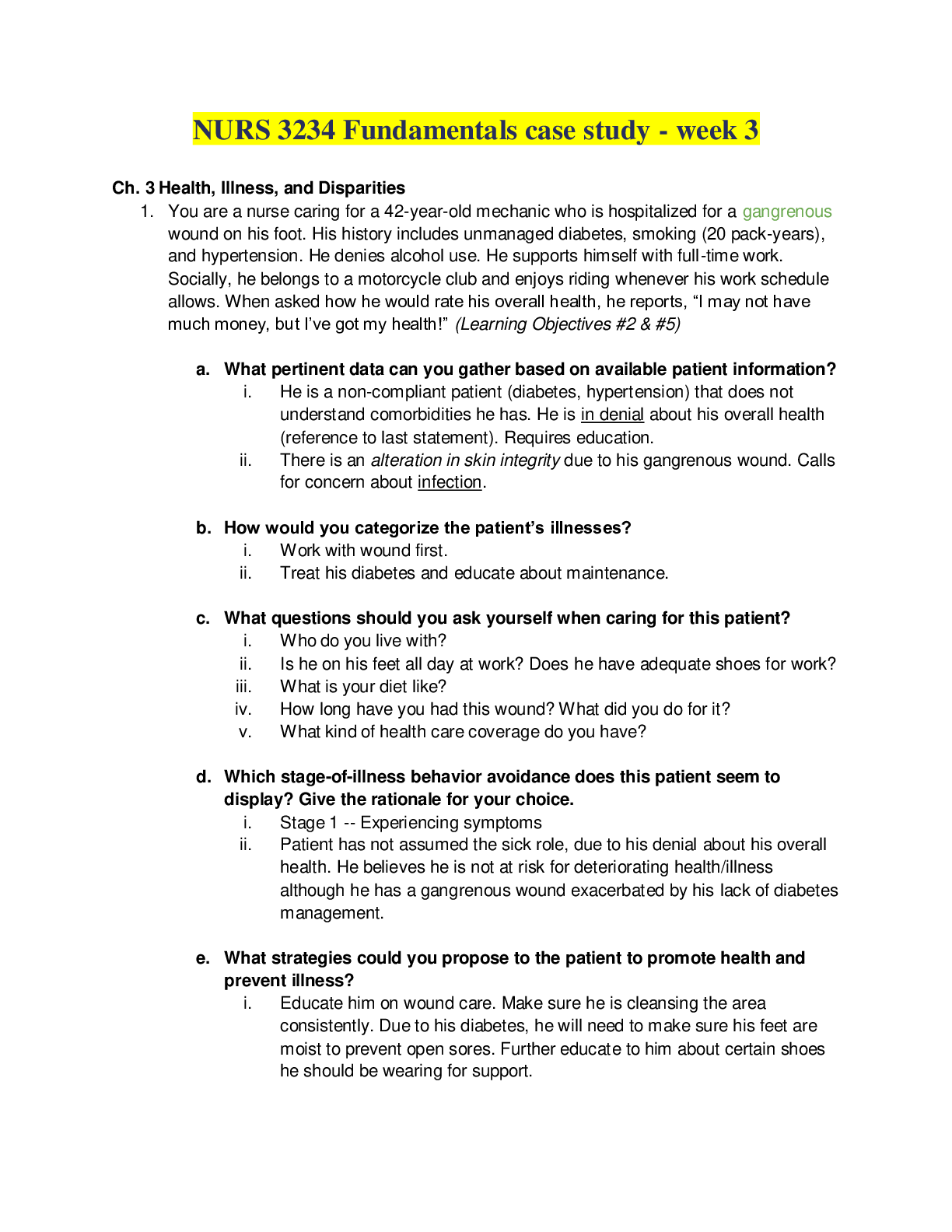
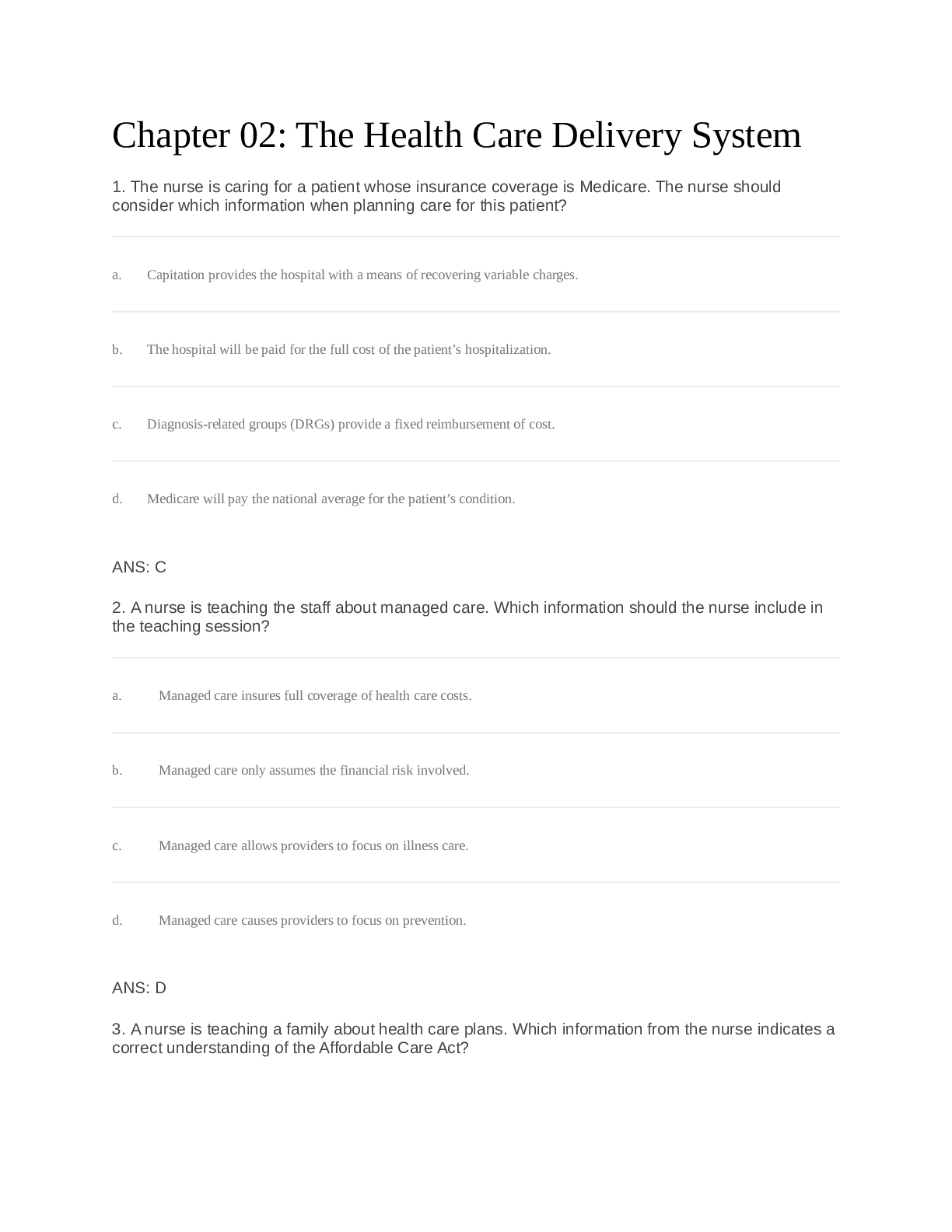

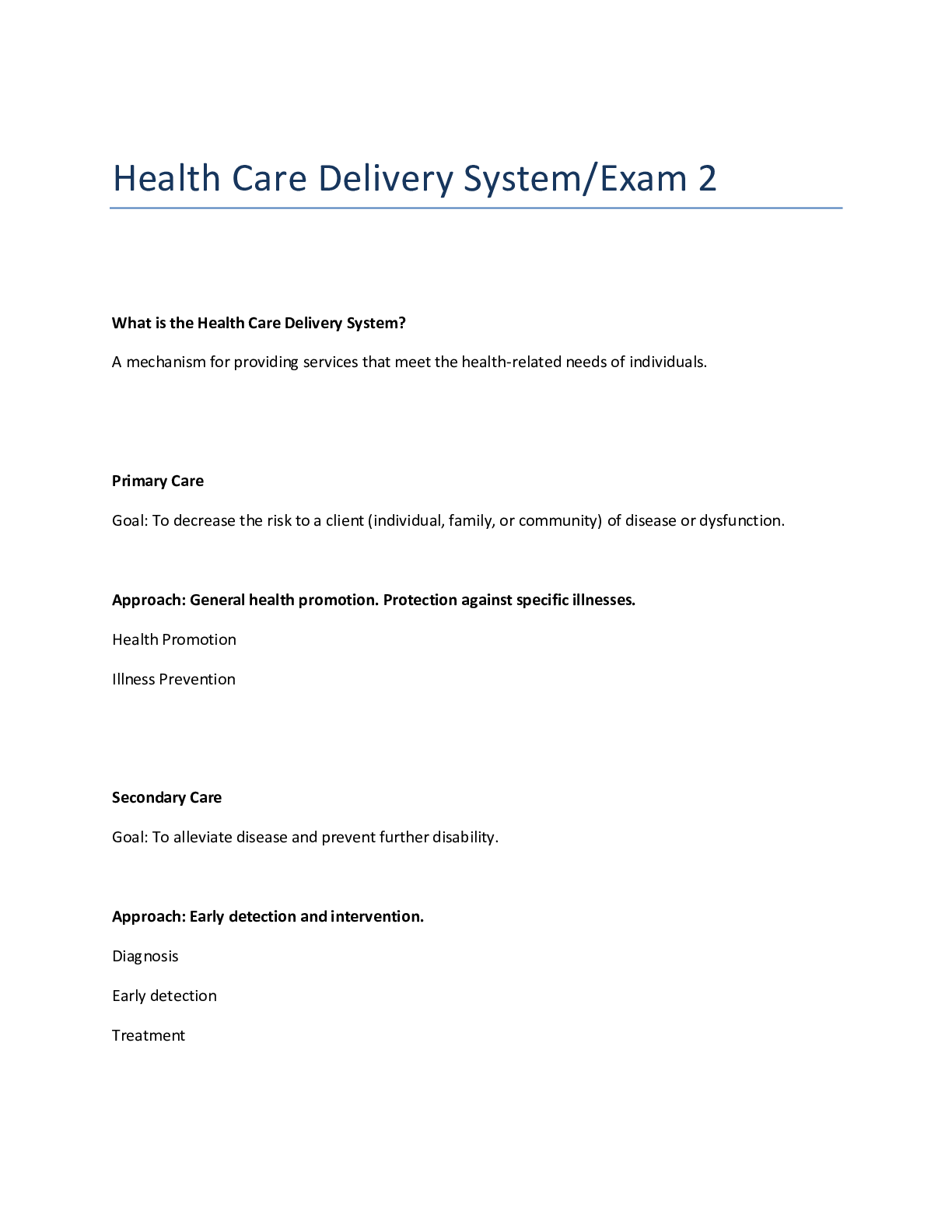
.png)

